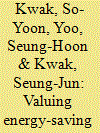| Srl | Item |
| 1 |
ID:
126562


|
|
|
|
|
| Publication |
2013.
|
| Summary/Abstract |
This paper attempts to measure consumers' perceived net benefits (or net costs) of energy-saving measures in using energy-consuming durable goods. Using the estimated net costs and the volume of CO2 reduced by the measures, a marginal abatement cost (MAC) curve for the average household's CO2 emissions is produced. An analysis using the curve suggests that in order to provide households with an incentive to take actions that can lead to CO2 emission reductions in using energy-consuming durables, a high level of carbon price is needed. In addition, a regression analysis reveals that the net benefits of the measures are larger for households that put a higher priority on energy saving, for those living in detached houses, for those with a smaller number of persons living together, and for those with less income. The result of the analysis using the MAC curve may suggest that promoting energy-saving behavior will require not only a policy to provide economic incentives but also interventions to influence psychological factors of household behavior.
|
|
|
|
|
|
|
|
|
|
|
|
|
|
|
|
| 2 |
ID:
093550


|
|
|
|
|
| Publication |
2010.
|
| Summary/Abstract |
Air-conditioning and heating energy-saving measures can cut back the usage of energy. This paper attempts to apply a choice experiment in evaluating the consumer's willingness to pay (WTP) for air-conditioning and heating energy-saving measures in Korea's residential buildings. We consider the trade-offs between price and three attributes of energy-saving (window, facade, and ventilation) for selecting a preferred alternative and derive the marginal WTP (MWTP) estimate for each attribute. We also try to test irrelevant alternatives property for the estimation model holds and compare the estimation results of the multinomial logit (MNL) and the nested logit (NL) models. The NL model outperforms the MNL model. The NL model show that MWTPs for increasing the number of glasses and their variety, for increasing the thickness of facade for 1 mm, and for establishing a ventilation system are KRW 17,392 (USD 18.2), 1,112 (1.2), and 11,827 (12.4), respectively. Overall, the potential consumers have significant amount of WTP.
|
|
|
|
|
|
|
|
|
|
|
|
|
|
|
|